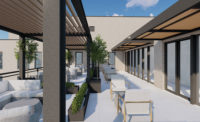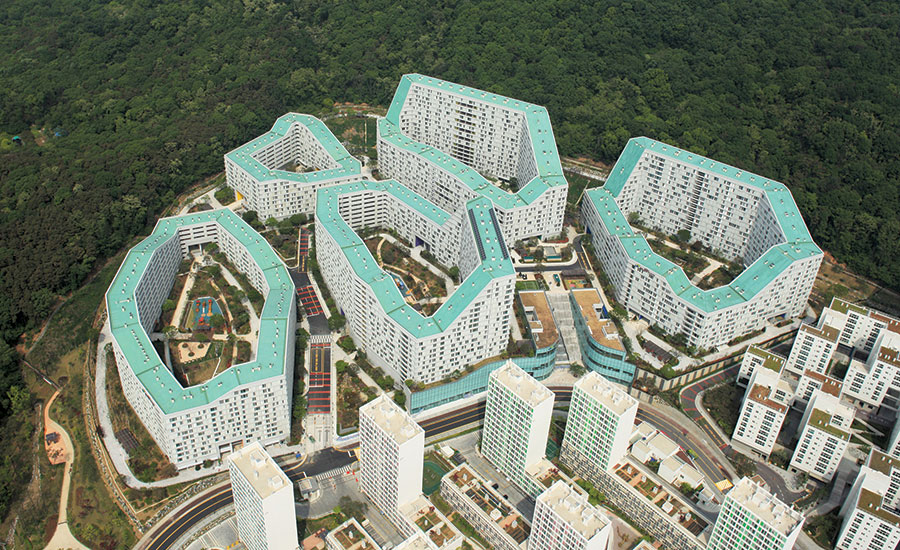Welcome to My House: Multifamily Housing
From superblocks to revamped office and industrial spaces to new structures that combine supportive and market-rate housing, home takes on a whole new meaning in the 21st century.

Frits van Dongen reintroduced the superblock for a housing development in Seoul’s Gangnam District.
Photo © Myoung Sik Kim

With an initial conceptual design by OMA, FAA + XDGA 15 architects designed new buildings for living, working, retail, and education on the roof and in the interior of a former storage hall in Paris.
Photo © Thomas Mayer

Designed by PLP Architecture, the Collective Old Oak in West London is currently the world’s largest co-living space.
Photo © Jack Hobhouse

Morris Adjmi Architects created a 33-unit condo building by developing a mirror image of a historic red-brick and terra-cotta warehouse in New York.
Photo © Field Condition

Designed for low-income families, 1180 Fourth Street in San Francisco features a courtyard for sports and film screenings.
Photo © Bruce Damonte





Visit any prosperous city these days, particularly in the U.S., and here’s what you’ll see: an abundance of housing on the rise. Glass towers with zippered balconies in some neighborhoods, stucco-clad apartment blocks in others. Angled boxes that slide three or four units into neighborhoods where single-family houses were the norm, and boldly patterned slabs amid the parking lots and warehouses of faded industrial zones.
But no matter the city, no matter the design style of choice, I’ll wager that you also hear concerns that this construction isn’t enough. All these new structures with their roof decks and bike rooms and dog-washing stations are too rarely accompanied by ones that put roofs over the heads of the average worker. Or seniors on tight budgets. Or couples with no real recourse, if they lose their current home, than to end up on the streets.
This is the dilemma we face today. The need for housing is so profound—across all spectrums of society—but government hasn’t caught up and financial resources are scarce. However, potential remedies do exist.
Nobody knows this better than architects—the ones with a social conscience, at any rate—who are exploring forms of living arrangements that might expand the options and pull down the costs. Micro-units are the current rage, compounds of efficiently minuscule, though not necessarily cheap, apartments geared to singles who don’t mind eating out six nights a week. Some architects are exploring the idea of newly constructed “group housing,” with communal kitchens and ADA-compliant bathrooms for each batch of small “suites.” Cohousing is an older example—distinct housing units designed and managed to allow families to share responsibilities and common space. Millennials today enjoy concierge service and group activities in co-living buildings. The ever-hopeful forays into modular or prefab housing are another—that confidence that someday, somebody will crack the nut and bring cheap construction methods to the masses.
Tiny houses, anyone?
All these ventures are laudable because, realistically, the best answer is: offer as many answers as possible. Unfortunately, American cities today would rather put up roadblocks than clear the way for innovation. That’s certainly what I’ve observed in San Francisco, where residents of wealthy towers portray themselves as environmentalists while they file lawsuits to keep other towers from crowding their views. Meanwhile, so-called “progressive” activists in 2016 went to the ballot in an unsuccessful effort to block any new market-rate housing from being built in the heavily Latino Mission District. Their rationale was that if you stopped new development there would be no more gentrification (so much for the laws of supply and demand, or the fact that developers were attracted to the Mission because of the gentrification that already had occurred).
“Housing is the ultimate architectural problem of our time,” says Mark Macy, a San Francisco architect who won praise for cultural spaces designed with then-partner Mark Jensen before starting his own firm in 2008, focused on housing. “We need innovations—but innovation is considered risky, so banks hesitate, even if you can show there’s a market.”
In 2013, Macy worked with developer Build Inc. to conceive a 21st century market-rate version of a large Victorian house after it had been split into smaller residences: within the six-story complex in San Francisco’s South of Market district, there’d be 28 “group houses,” with 470 beds divided among 235 “suites” of under 250 square feet. Each suite would have a tiny bedroom and cooking area, while each “house” included more enticing (and code-compliant) facilities.
Think of post-collegiate dorms, or micro-units taken to the next level. But by the time the complex was approved last fall, the numbers had frayed beneath the weight of city fees geared to conventional housing and higher lending fees. What will break ground in 2017 looks the same on the outside—but inside there will be 119 conventional units, mostly studios, holding 172 bedrooms in all.
Even if governments and neighbors are willing to let experimentation reign, there are the financial hurdles. The logic behind cohousing is compelling, but conventional mortgages defined by the notion of individual ownership don’t fit a “product” that by its nature is communal. The issue isn’t whether they provide good homes—more than 150 have been developed in the United States since the late 1980s; it’s whether banks can be convinced to fund construction or underwrite mortgages of something that’s not the norm.
Factors like these help to explain why so many new housing complexes seem interchangeable. There are a limited number of easily financed housing models, each one producing variations on the same monochromatic theme, marketed to niches that are more complex in real life than on a developer website. The generic approach shrugs off geography as well: a five-story chunk of infill market-rate housing, wood frame above concrete base, is likely to take the same form in Minneapolis or Albuquerque, Dallas or Denver, no matter the climate or terrain.
This isn’t how things should be in our world, where the deceptively simple notion of “household” has atomized in recent decades. But then, such one-size-fits-all thinking has always come up short—or at least it has since 1944, when the Museum of Modern Art asked in the catalogue for its Built in USA, 1932–1944 exhibition: “Isn’t it socially and architecturally preferable to plan each neighborhood for the various needs of many kinds of individuals and families, rather than for any one special income group and family type?”
The appropriate response is yes, of course. That’s why it is exciting, despite all the bureaucratic and corporate obstacles, to see architects striving to produce innovative and urbanistically appropriate living options across the social, cultural, and economic spectrums.
This can mean the addition of new housing in historic districts, such as the richly rigorous Corner House by DSDHA in London, or the redevelopment of Denver’s South Lincoln housing project as the Mariposa District, an ongoing effort that increases the number of apartments from 270 to 800, half of them subsidized for low-income residents. There’s a different architectural firm for each block, to provide a varied landscape across the 18-acre site. As a whole, it blends the edges into the surrounding neighborhood of single-family houses.
Architecture also can turn heads. In South Korea, the long-discredited notion of superblocks is being reinterpreted sculpturally for public housing by Dutch architect Frits van Dongen; in New York, Bjarke Ingels’s Via 57 West strives to recast the residential skyscraper as a notched, silvery pyramid. In San Francisco, 1180 Fourth Street—the portal building to the redevelopment district where the Golden State Warriors will build their new arena—is a 150-unit complex of low-income family apartments designed by Mithun and Kennerly Architecture.
Again, there’s no single solution. Nor can worthy architecture overcome decades of federal neglect and local inertia. In San Francisco, I can show you a dozen affordable-housing projects designed by local architects for local nonprofit developers that any city would be proud to have. I also can show you clusters of tents filled by homeless people.
But good architects can produce good models, attractive and tactile structures showing us that the future needn’t be as frustrating as the recent past. With luck, those models will be noticed—and emulated— more and more in the years to come.









